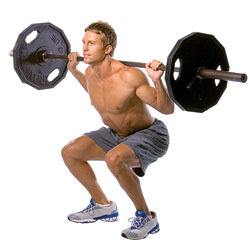Exercise Technique Article Series, 2
The squat exercise (with or without weights) should be a part of your workout regimen. It is an exercise that requires leg strength, core strength and good posture. It is a great exercise to build muscle and burn fat. And, squatting is something we do in every day life. Unfortunately, the squat exercise has gotten a bad rap from some people.
Some have experienced injury from doing the squat exercise because of incorrect technique or from "maxing out" on the squat. I don't ever recommend "maxing out." You're asking for low back and knee injuries if you do "max out."

1. Get a tight grip with the bar resting on your shoulders. Your elbows should be pointed downward to help you keep your upper back (trapezius muscles) contracted and to keep your back from rounding.
Lift the bar off the rack, step back and stand with your feet a little wider than shoulder width. The toes should be turned slightly outward to keep undue pressure off of your knees.
2. Take a deep breath and begin the lift. Push your head and shoulders up and back (keeps the bar from coming forward) and push your hips back as you bend your knees. The bar, knees and feet should be in a vertical line.
Maintain the normal arch in your lower back at all times while keeping your posture as upright as possible (don't let your shoulders fall forward). You don't have to lower your thighs to below parallel.
3. Don't let your knees cave in at any point in the squat exercise. As you lower the bar, try to push your feet outward without actually moving them.
This will keep your knees aligned properly. Once you have lowered to the desired squat position, contract your glutes and thighs and explode upward to the starting position and exhale. You have done one repetition!
Don't substitute the squat exercise with lunges, leg presses, leg extensions, etc. Instead, supplement the squat exercise with these other leg exercises. And, there are many variations of the squat exercise such as single-leg squats, body-weight squats, dumbbell squats and prisoner squats.
In part 3 of this series, I will cover correct technique for the seated row exercise.
Some have experienced injury from doing the squat exercise because of incorrect technique or from "maxing out" on the squat. I don't ever recommend "maxing out." You're asking for low back and knee injuries if you do "max out."

1. Get a tight grip with the bar resting on your shoulders. Your elbows should be pointed downward to help you keep your upper back (trapezius muscles) contracted and to keep your back from rounding.
Lift the bar off the rack, step back and stand with your feet a little wider than shoulder width. The toes should be turned slightly outward to keep undue pressure off of your knees.
2. Take a deep breath and begin the lift. Push your head and shoulders up and back (keeps the bar from coming forward) and push your hips back as you bend your knees. The bar, knees and feet should be in a vertical line.
Maintain the normal arch in your lower back at all times while keeping your posture as upright as possible (don't let your shoulders fall forward). You don't have to lower your thighs to below parallel.
3. Don't let your knees cave in at any point in the squat exercise. As you lower the bar, try to push your feet outward without actually moving them.
This will keep your knees aligned properly. Once you have lowered to the desired squat position, contract your glutes and thighs and explode upward to the starting position and exhale. You have done one repetition!
Don't substitute the squat exercise with lunges, leg presses, leg extensions, etc. Instead, supplement the squat exercise with these other leg exercises. And, there are many variations of the squat exercise such as single-leg squats, body-weight squats, dumbbell squats and prisoner squats.
In part 3 of this series, I will cover correct technique for the seated row exercise.
If you want to take your workouts to a higher level and blowtorch body fat, my FREE Bodyweight Metabolic Fat Burner Workouts are what you need. There are 3 levels: Bodyweight 200, 300 and 500. Start at the level you can handle.





